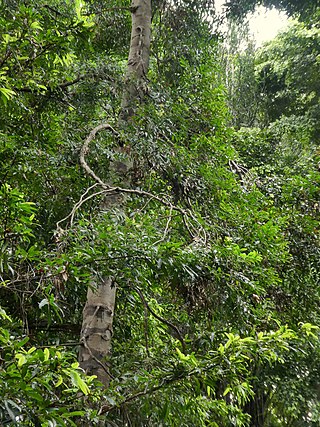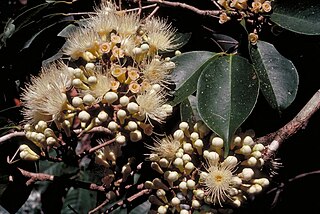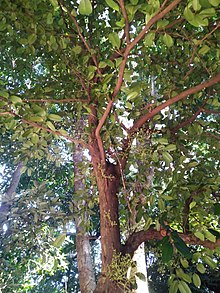
Agathis atropurpurea, commonly known as the blue kauri, and occasionally as the black kauri or purple kauri, is a species of conifer in the very ancient plant family Araucariaceae. The family was distributed almost worldwide during the Jurassic and Cretaceous periods, but is now mostly confined to the Southern Hemisphere. This species is endemic to a small part of northeastern Queensland, Australia.

Didymocheton pettigrewianus, commonly known as spur mahogany, spurwood, or Cairns satinwood, is a large tree in the family Meliaceae. It is native to the rainforests of Malesia, Papuasia and Queensland. In Queensland it occurs only in a small part of the northeast coast.

Carnarvonia araliifolia, commonly known as the red oak, red silky oak, Caledonian oak or elephant's foot, is the sole species in the genus Carnarvonia, a member of the Proteaceae family. It is endemic to the rainforests of northeastern Queensland, Australia.

Dillenia alata, commonly known as red beech, golden guinea flower or golden guinea tree, is a tree in the Dilleniaceae family, found in tropical forests of the Moluccas, New Guinea, and northern Australia.

Syzygium alliiligneum, commonly known as onionwood, Mission Beach satinash or bark in the wood is a species of plant in the family Myrtaceae. It is endemic to a small part of north eastern Queensland.

Syzygium angophoroides, commonly known as bark in wood, Yarrabah satinash, or swamp satinash, is a tree of the family Myrtaceae native to Western Australia, the Northern Territory and Queensland in Australia, which grows to a height of 6 to 35 m. It blooms between July and November producing cream flowers, followed by small fruits about 9 mm long by 13 mm wide, which turn dark purple or blackish when ripe.

Syzygium forte, commonly known as flaky-barked satinash, white apple or brown satinash, is a tree in the family Myrtaceae native to New Guinea and northern Australia.

Atractocarpus hirtus, commonly known as the hairy gardenia or native loquat, is a plant in the coffee family Rubiaceae, a large family of some 6,500 species with a cosmopolitan distribution. This species is endemic to northeastern Queensland, Australia.

Cleistanthus hylandii, commonly known as Bernie's Cleistanthus, is an evergreen plant in the family Phyllanthaceae which is endemic to Cape York Peninsula in far northern Queensland, Australia.

Syzygium unipunctatum, commonly known as the rolypoly satinash, is a small tree in the family Myrtaceae. It is endemic to the rainforests of the Wet Tropics of Queensland.

Syzygium tierneyanum, commonly known as river cherry, water cherry, or Bamaga satinash, is a tree in the family Myrtaceae which is native to New Guinea, the Solomon Islands, Vanuatu and north east Queensland. It often grows along watercourses where it is a facultative rheophyte.

Hypserpa laurina is a slender twining climber in the plant family Menispermaceae. It is native to New Guinea and northeastern Queensland in Australia.

Harpullia ramiflora, commonly known as the Claudie tulipwood or Cape York tulipwood, is a tree in the Sapindaceae family native to north east Queensland, New Guinea and parts of Malesia.

Syzygium sayeri, commonly known as pink satinash, is a plant in the family Myrtaceae which is native to northeastern Queensland, Australia, and New Guinea.

Sterculia shillinglawii, commonly known as tulip sterculia or lacewood, is a tree in the cotton and cocoa family Malvaceae, native to Papuasia and northeastern Australia.

Syzygium puberulum, commonly known as white satinash or downy satinash, is a plant in the family Myrtaceae which is native to rainforests of Cape York Peninsula, Queensland, and Papua New Guinea. It was first described in 1942.
Aglaia cooperae, commonly known as Cooper's aglaia, is a small tree growing to about 4–6 m (13–20 ft) tall in the mahogany family Meliaceae. Twigs, leaves, leaf stalks, flowering and fruiting structures, the outside surfaces of the petals, calices and fruit are all covered in a dense reddish brown indumentum.

Psychotria coelospermum is a small climbing plant in the coffee family Rubiaceae found only in the Northern Territory and Queensland, Australia. The leaves are paired and measure up to 14 cm long by 7 cm wide. Flowers are produced in panicles from October to December, followed by white fruits about 15 mm diameter from February to June. It grows in swamps and very wet areas in rainforest.

Syzygium alatoramulum, commonly known as tinkling satinash, is a plant in the clove and eucalyptus family Myrtaceae, found only in the Wet Tropics bioregion of Queensland, Australia.

Syzygium graveolens, commonly known as cassowary satinash, is a plant in the eucalyptus family Myrtaceae found only in the Wet Tropics bioregion of Queensland, Australia.



























